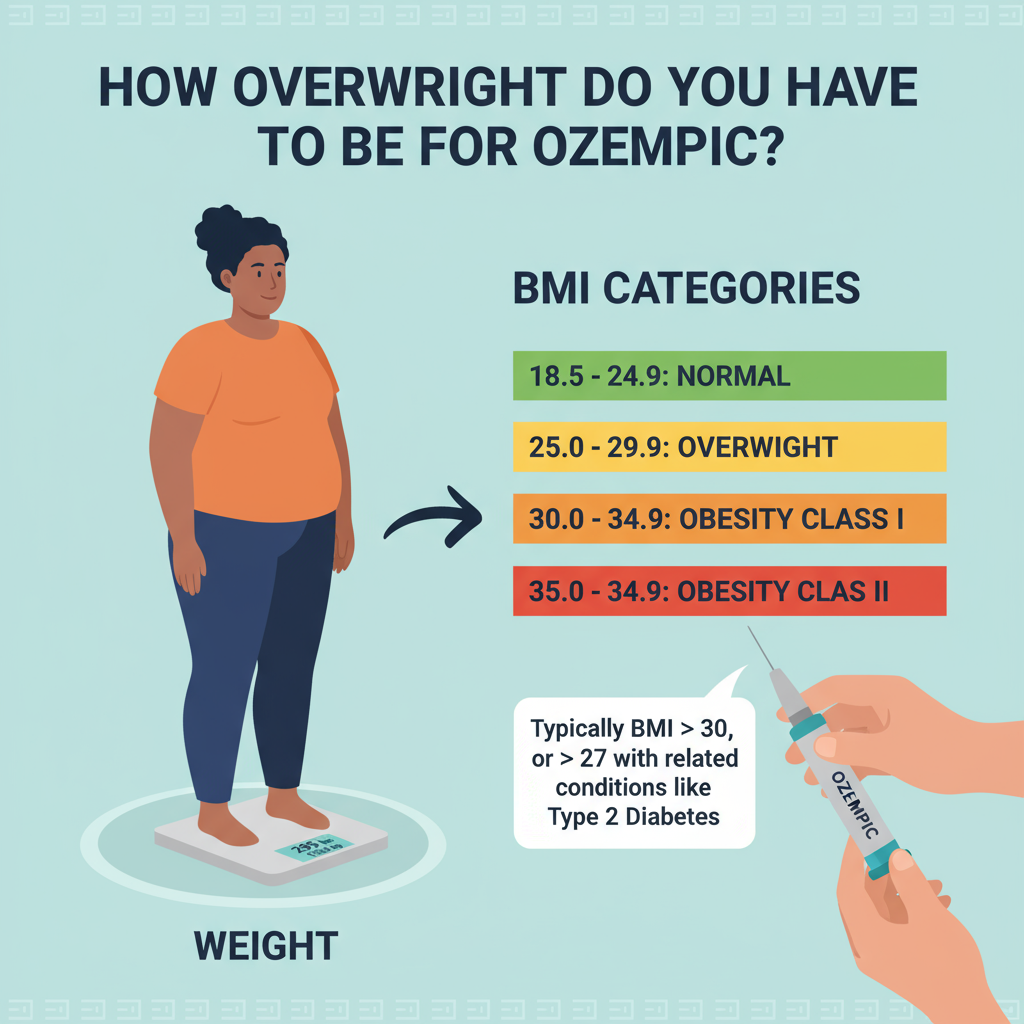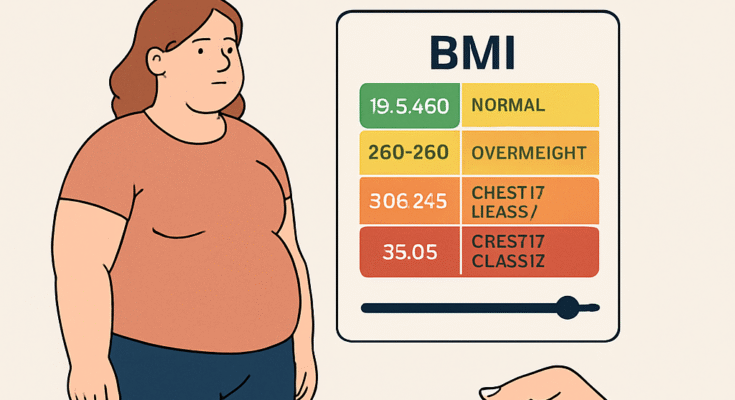The rise of GLP-1 agonist weight loss drugs has transformed obesity treatment, with semaglutide weight loss drug formulations like Ozempic and Wegovy leading the conversation. But understanding Ozempic eligibility criteria BMI requirements, prescription weight requirements, and whether you qualify for this medication can be confusing. This comprehensive guide breaks down everything you need to know about Ozempic weight loss qualification, including body mass index requirement for Ozempic, insurance coverage considerations, and how this medication compares to other obesity treatment guidelines.
Understanding Ozempic Prescription Weight Requirements
When exploring semaglutide BMI threshold for use, it’s essential to understand that Ozempic eligibility isn’t determined by a specific number on the scale. Instead, healthcare providers evaluate candidates using body mass index requirement for Ozempic alongside other clinical factors.
Ozempic Eligibility Criteria BMI Standards

The Ozempic prescription weight requirements typically include:
- BMI of 30 kg/m² or higher (classified as obesity according to BMI categories overweight obesity definitions)
- BMI of 27 kg/m² or higher with at least one weight-related comorbidity
These Ozempic eligibility criteria BMI thresholds align with standard obesity treatment guidelines used by healthcare providers worldwide. The body mass index requirement for Ozempic ensures that the medication is prescribed to patients who will benefit most from GLP-1 agonist weight loss drugs intervention.
Weight-Related Conditions That Impact Eligibility
When evaluating how much overweight to take semaglutide, doctors consider accompanying health conditions. Ozempic for overweight patients may be prescribed when BMI reaches 27 kg/m² alongside:
- Hypertension (high blood pressure)
- Dyslipidemia (high cholesterol)
- Type 2 diabetes mellitus
- Obstructive sleep apnea
- Cardiovascular disease risk factors
- Metabolic syndrome and obesity-related complications
This comprehensive approach to Ozempic weight loss qualification ensures the medication serves those facing genuine health risks, not just cosmetic concerns.
Ozempic Official Prescribing Information: FDA-Approved Uses
According to Ozempic official prescribing information, the medication is FDA-approved specifically for Type 2 diabetes management, not primarily as a weight loss intervention. However, Ozempic weight loss off label use has become increasingly common as physicians recognize the medication’s effectiveness for obesity treatment.
Ozempic vs Wegovy Weight Eligibility: Key Differences

Many patients wonder about Ozempic vs Wegovy weight eligibility since both contain semaglutide weight loss drug as their active ingredient. Here’s the distinction:
Ozempic:
- FDA-approved for Type 2 diabetes
- Available in 0.5 mg, 1 mg, and 2 mg doses
- Often prescribed off-label for weight management
- Requires diabetes diagnosis for insurance coverage in most cases
Wegovy:
- FDA-approved specifically for chronic weight management
- Higher maximum dose (2.4 mg)
- Prescribed for obesity treatment guidelines compliance
- May have different insurance coverage for weight loss drugs requirements
Understanding these differences helps clarify Ozempic weight loss qualification versus Wegovy’s more straightforward obesity treatment indication.
Does Ozempic Require Obesity Diagnosis?
A common question is whether Ozempic for obesity treatment guidelines strictly requires an obesity diagnosis. The answer depends on the intended use:
For diabetes management, Ozempic doesn’t require obesity diagnosis—only confirmed Type 2 diabetes.
For weight loss purposes (off-label), healthcare providers typically require:
- BMI meeting obesity or overweight thresholds
- Documentation of previous weight loss attempts
- Assessment of weight-related health complications
The Ozempic eligibility guide Novo Nordisk provides emphasizes that prescribing decisions should be individualized based on comprehensive medical evaluation, not BMI alone.
Who Qualifies for Ozempic for Weight Loss?
When determining Ozempic weight loss qualification, healthcare providers consider multiple factors beyond simple weight measurements. The semaglutide BMI threshold for use serves as a starting point, but clinical judgment plays a crucial role.
Comprehensive Eligibility Assessment
Ozempic for overweight patients involves evaluating:
- Body Composition: Current BMI and body fat distribution
- Medical History: Previous weight loss attempts and their outcomes
- Comorbidities: Presence of obesity-related health conditions
- Lifestyle Factors: Diet, physical activity, and behavioral patterns
- Contraindications: Medical conditions that might preclude safe use
This thorough approach ensures that Ozempic prescription weight requirements serve patient safety and efficacy goals.
Age and General Health Considerations
According to Ozempic official prescribing information and clinical practice guidelines:
- Approved for adults aged 18 and older
- Requires comprehensive cardiovascular assessment
- Not recommended during pregnancy or breastfeeding
- May require dose adjustments for kidney or liver conditions
These criteria ensure responsible prescribing aligned with Ozempic for obesity treatment guidelines.
Can You Take Ozempic Without Being Overweight?
The question of whether individuals can use Ozempic without meeting body mass index requirement for Ozempic standards is important. Medical experts strongly advise against Ozempic weight loss off label use in people with normal BMI.
Why BMI Thresholds Matter
The semaglutide BMI threshold for use isn’t arbitrary. These limits exist because:
- Safety Concerns: Individuals at healthy weight face different risk-benefit profiles
- Efficacy Questions: Medication designed for obesity may not work appropriately at normal weight
- Side Effect Risks: Ozempic side effects weight loss complications can be more pronounced without medical necessity
- Ethical Considerations: Medication should serve health needs, not cosmetic preferences
Healthcare providers following Ozempic eligibility criteria BMI guidelines refuse prescriptions for patients who don’t meet medical necessity standards.
The Dangers of Cosmetic Use
Using GLP-1 agonist weight loss drugs without meeting how much overweight to take semaglutide criteria can lead to:
- Unnecessary gastrointestinal side effects
- Potential muscle loss instead of fat loss
- Nutritional deficiencies
- Psychological dependence on medication for weight management
Responsible prescribing requires adherence to established Ozempic prescription weight requirements.
Using Ozempic to Lose 20 Pounds: Is It Appropriate?
Many people wonder if Ozempic for overweight patients applies when seeking modest weight loss, such as 20 pounds. The answer depends on overall health context.
Short-Term vs. Long-Term Weight Management
Ozempic for obesity treatment guidelines emphasize long-term metabolic health improvement rather than rapid weight reduction. The medication works best when:
- Combined with sustainable lifestyle modifications
- Part of comprehensive obesity management strategy
- Used for extended periods (6-12+ months)
- Monitored by healthcare professionals
The semaglutide weight loss drug mechanism isn’t designed for quick cosmetic changes but rather sustained metabolic improvement.
Realistic Weight Loss Expectations
When evaluating Ozempic weight loss qualification outcomes, clinical studies show:
- Average weight loss of 10-15% of starting body weight over 68 weeks
- Monthly progress typically ranges from 2-5 pounds initially
- Results vary based on adherence, lifestyle factors, and individual metabolism
- Plateaus are common and expected
Understanding these patterns helps patients approach treatment with realistic expectations aligned with obesity treatment guidelines.
How GLP-1 Agonist Weight Loss Drugs Work
To understand Ozempic eligibility criteria BMI requirements, it helps to know how GLP-1 agonist weight loss drugs function in the body.
The Science Behind Semaglutide Weight Loss Drug Mechanism
Ozempic (semaglutide) mimics glucagon-like peptide-1 (GLP-1), a naturally occurring hormone. This mechanism involves:
Appetite Regulation:
- Activates GLP-1 receptors in the brain’s appetite centers
- Reduces hunger signals and cravings
- Promotes earlier satiety during meals
Glycemic Control:
- Stimulates insulin secretion when blood glucose is elevated
- Suppresses inappropriate glucagon release
- Reduces hepatic glucose production
Gastric Emptying:
- Slows stomach emptying rate
- Extends feeling of fullness after meals
- Reduces post-meal blood sugar spikes
These combined effects explain why semaglutide BMI threshold for use focuses on individuals with metabolic dysfunction who benefit most from these mechanisms.
Comparing Ozempic to Other Obesity Medications
When considering Ozempic vs Wegovy weight eligibility and other options like tirzepatide (Mounjaro) obesity eligibility, key differences emerge:
Ozempic/Wegovy (Semaglutide):
- Single GLP-1 agonist action
- Once-weekly injection
- Established safety profile
- Extensive clinical trial obesity data
Mounjaro/Zepbound (Tirzepatide):
- Dual GIP/GLP-1 receptor agonist
- Potentially greater weight loss
- Similar administration schedule
- Newer to market with evolving data
Understanding these distinctions helps patients and providers select appropriate interventions based on individual needs and Ozempic eligibility criteria BMI profiles.
Ozempic Side Effects Weight Loss Considerations
While evaluating body mass index requirement for Ozempic, it’s crucial to understand Ozempic side effects weight loss patients commonly experience.
Common Side Effects
Most Ozempic side effects weight loss users report include:
- Nausea (especially during dose escalation)
- Vomiting
- Diarrhea
- Constipation
- Abdominal pain
- Fatigue
These effects often diminish as the body adjusts to the medication, typically within 4-8 weeks.
Serious Potential Complications
According to Ozempic official prescribing information, rare but serious risks include:
- Pancreatitis (inflammation of the pancreas)
- Gallbladder disease
- Kidney problems
- Diabetic retinopathy complications
- Thyroid C-cell tumors (animal studies)
Healthcare providers weighing Ozempic weight loss qualification must balance potential benefits against these risks based on individual patient profiles.
Getting an Ozempic Prescription: Practical Steps
For those who meet Ozempic prescription weight requirements, obtaining the medication involves several steps.
Consulting Healthcare Providers
To get prescription Ozempic obesity treatment:
- Schedule comprehensive medical evaluation with your primary care physician or endocrinologist
- Discuss weight history including previous attempts at diet, exercise, and other interventions
- Review medical conditions that might affect Ozempic eligibility criteria BMI assessment
- Undergo necessary testing including blood work, BMI calculation, and health screening
Finding Ozempic weight management clinics near me that specialize in obesity medicine can provide access to providers experienced with GLP-1 agonist weight loss drugs.
Insurance Coverage for Weight Loss Drugs
One significant barrier involves insurance coverage for weight loss drugs. Coverage varies widely:
Medicare:
- Generally does not cover weight loss medications
- May cover Ozempic for diabetes but not weight management
Private Insurance:
- Coverage depends on specific plan
- May require prior authorization
- Often covers diabetes indication but not weight loss off label use
Ozempic Patient Assistance Program Eligibility:
- Novo Nordisk offers savings programs
- Income requirements apply
- Can significantly reduce out-of-pocket costs
Understanding these financial considerations is essential when evaluating how much overweight to take semaglutide given cost factors.
Ozempic Clinical Trial Obesity Evidence
The Ozempic clinical trial obesity research base helps establish current eligibility guidelines.
STEP Trials: Foundational Research
The Semaglutide Treatment Effect in People with Obesity (STEP) trials demonstrated:
- 15-20% average body weight reduction with semaglutide 2.4 mg
- Improved cardiometabolic markers
- Better quality of life outcomes
- Sustained results with continued treatment
These findings support current Ozempic for obesity treatment guidelines and semaglutide BMI threshold for use recommendations.
Real-World Effectiveness
Beyond controlled trials, real-world data shows:
- Effectiveness varies more than in clinical settings
- Adherence challenges affect outcomes
- Long-term sustainability requires ongoing support
- Integration with lifestyle modification enhances results
This evidence base continues informing Ozempic weight loss qualification criteria and prescribing practices.
Metabolic Syndrome and Obesity: The Bigger Picture
Understanding metabolic syndrome and obesity connections clarifies why Ozempic eligibility criteria BMI requirements exist.
What Is Metabolic Syndrome?
Metabolic syndrome involves clustering of:
- Abdominal obesity (increased waist circumference)
- Elevated blood pressure
- High fasting glucose
- Elevated triglycerides
- Low HDL cholesterol
Having three or more components increases cardiovascular disease and diabetes risk significantly.
How Obesity Treatment Addresses Metabolic Health
GLP-1 agonist weight loss drugs like Ozempic address multiple metabolic syndrome components simultaneously by:
- Reducing body weight and visceral fat
- Improving insulin sensitivity
- Lowering blood pressure
- Improving lipid profiles
- Reducing inflammation markers
This comprehensive impact explains why body mass index requirement for Ozempic extends beyond simple weight thresholds to encompass broader metabolic health considerations.
BMI Categories Overweight Obesity Definitions
To understand Ozempic prescription weight requirements, familiarity with BMI categories overweight obesity definitions is essential.
Standard BMI Classifications
According to the World Health Organization:
- Underweight: BMI below 18.5 kg/m²
- Normal weight: BMI 18.5-24.9 kg/m²
- Overweight: BMI 25.0-29.9 kg/m²
- Obesity Class I: BMI 30.0-34.9 kg/m²
- Obesity Class II: BMI 35.0-39.9 kg/m²
- Obesity Class III: BMI 40.0 kg/m² or higher
These BMI categories overweight obesity definitions inform how much overweight to take semaglutide decisions.
Limitations of BMI
While useful for population-level assessment, BMI has limitations:
- Doesn’t distinguish muscle from fat mass
- May not accurately reflect body composition in athletes
- Doesn’t account for fat distribution patterns
- May vary by ethnicity and age
Healthcare providers consider these factors alongside BMI when evaluating Ozempic eligibility criteria BMI requirements.
Alternative and Complementary Approaches
While Ozempic for overweight patients offers significant benefits, comprehensive obesity treatment guidelines emphasize multimodal approaches.
Lifestyle Interventions
Foundation of obesity management includes:
- Nutrition counseling: Balanced, sustainable dietary patterns
- Physical activity: Minimum 150 minutes moderate activity weekly
- Behavioral therapy: Addressing emotional eating and habit formation
- Sleep optimization: Adequate rest supports metabolic health
- Stress management: Reducing cortisol and emotional triggers
These interventions enhance Ozempic weight loss off label use effectiveness when combined appropriately.
Other Medical Interventions
For patients who don’t meet Ozempic prescription weight requirements or need alternatives:
- Other GLP-1 agonist weight loss drugs (liraglutide, dulaglutide)
- Combination medications (phentermine-topiramate, naltrexone-bupropion)
- Bariatric surgery for severe obesity
- Endoscopic weight loss procedures
Comparing options like tirzepatide (Mounjaro) obesity eligibility versus Ozempic helps identify best-fit solutions.
Making Informed Decisions About Ozempic
Understanding Ozempic eligibility criteria BMI requirements, potential benefits, and limitations empowers informed healthcare decisions.
Questions to Discuss With Your Provider
When exploring Ozempic weight loss qualification:
- Do I meet the semaglutide BMI threshold for use?
- What are my specific risk factors that warrant medication?
- What lifestyle modifications should accompany treatment?
- How will we monitor effectiveness and side effects?
- What’s the long-term plan for weight maintenance?
- Does my insurance provide coverage for weight loss drugs?
- Am I a candidate for Ozempic patient assistance program eligibility?
Setting Realistic Expectations
Success with GLP-1 agonist weight loss drugs requires:
- Understanding that medication supports, not replaces, lifestyle change
- Accepting gradual rather than rapid weight loss
- Committing to long-term treatment and monitoring
- Recognizing individual variability in response
- Preparing for potential Ozempic side effects weight loss users experience
Conclusion: Navigating Ozempic Eligibility
The question of how much overweight to take semaglutide doesn’t have a one-size-fits-all answer. Ozempic eligibility criteria BMI standards provide general guidance, but individual assessment by qualified healthcare providers determines appropriateness.
Key takeaways about Ozempic prescription weight requirements:
- BMI thresholds of 30+ or 27+ with comorbidities guide eligibility
- Medical necessity rather than cosmetic goals should drive prescribing
- Comprehensive evaluation considers multiple health factors beyond weight
- Long-term commitment to lifestyle modification enhances outcomes
- Insurance and cost considerations affect practical access
Whether exploring Ozempic for overweight patients or seeking information about Ozempic official prescribing information, working with knowledgeable healthcare providers ensures safe, effective, and appropriate use of these powerful medications.
For those who meet body mass index requirement for Ozempic and have struggled with obesity despite conventional interventions, GLP-1 agonist weight loss drugs represent important tools in comprehensive metabolic health management. Understanding eligibility criteria, mechanism of action, and realistic expectations sets the foundation for successful outcomes.
If you believe you might benefit from Ozempic or similar semaglutide weight loss drug interventions, consult with an obesity medicine specialist or endocrinologist who can evaluate your individual situation, explain your options, and guide you through the process safely and effectively.

Emily Harper is a board-certified nurse practitioner and certified obesity medicine specialist with a strong clinical background in metabolic health and GLP-1 therapies. With years of frontline experience managing patients on Ozempic, she brings both scientific knowledge and real-world insight to her writing.




